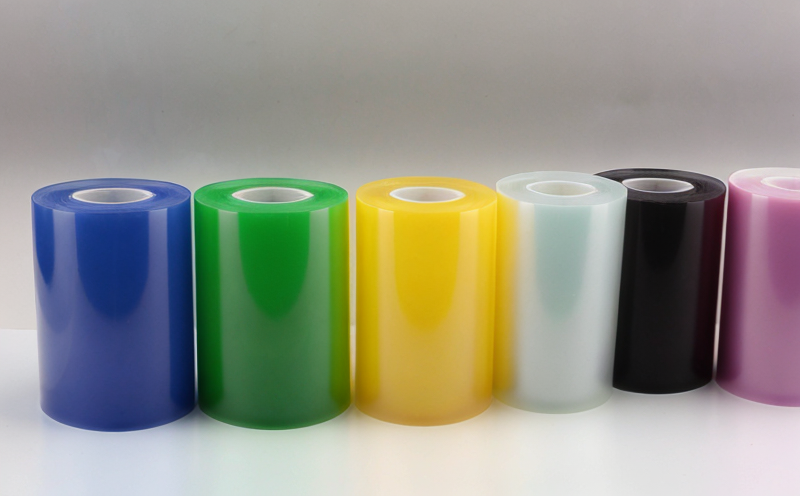EN ISO 22088 Stress Cracking Resistance Testing of Plastic Sheets
The EN ISO 22088 standard provides a method for determining the stress cracking resistance (SCR) of plastic sheets under conditions of tensile or flexural load. This test is particularly important in industries where materials are subjected to continuous mechanical loading, such as automotive components, packaging, and construction materials.
Stress cracking resistance testing evaluates how well a polymer can withstand applied stresses without undergoing catastrophic failure due to microcracking. The integrity of plastic sheets under these conditions is crucial for ensuring the durability and reliability of products in various sectors. This test method ensures that manufacturers meet the required standards for product quality and safety.
The test involves subjecting a specimen to a controlled tensile or flexural load, which simulates real-world stress conditions. The specimen is placed between two clamps, one fixed and one moving, with a specific distance between them. A force is applied gradually until the plastic sheet starts to exhibit signs of cracking under stress.
The key parameters for this test include:
- Specimen dimensions: Standardized according to ISO requirements
- Loading rate: Typically 5 mm/min or as specified by the client
- Type of load: Tensile or flexural, depending on the application
- Environmental conditions: Controlled temperature and humidity levels
The test apparatus used includes a universal testing machine equipped with grips for holding the specimen. The loading system must be capable of applying controlled forces up to the breaking point of the sample.
The acceptance criteria for this test are based on visual observation and can vary depending on the specific requirements set by the client or industry standards. Common acceptance criteria include:
- No visible stress cracks after the specified load application
- Specimen must not break within a certain percentage of its original length
- Specimen must maintain its integrity under cyclic loading
The results of this test are critical for quality control and product development. They provide valuable insights into the performance of plastic sheets under stress, helping to identify any weaknesses in material design or manufacturing processes.
In real-world applications, this testing method is used extensively across various sectors, including automotive, packaging, and construction. For example, in the automotive industry, it ensures that parts like dashboards and steering wheels withstand high loads without cracking. In packaging, it helps verify the durability of containers under stacking pressures. In construction, it assesses the strength of materials used in infrastructure.
The test results are typically reported in terms of stress at which cracking occurs or the percentage elongation before fracture. These metrics are crucial for understanding the material's performance and identifying any potential issues that need to be addressed during manufacturing or design phases.
Scope and Methodology
The scope of EN ISO 22088 focuses on determining the stress cracking resistance of plastic sheets under controlled tensile or flexural loading conditions. This includes testing materials such as polyethylene, polypropylene, and polycarbonate, which are commonly used in various industrial applications.
The methodology involves preparing specimens according to standard dimensions specified by ISO. The specimens are then subjected to a controlled load using a universal testing machine. The test is conducted at room temperature or under specified environmental conditions if required by the client. The loading rate is typically 5 mm/min, but it can be adjusted based on specific needs.
The stress cracking resistance of plastic sheets is evaluated by observing any signs of microcracking on the surface of the specimens after load application. The test results are reported in terms of the maximum load applied before cracking occurs or the percentage elongation before fracture. These metrics provide valuable insights into the material's performance under stress.
The test apparatus used includes a universal testing machine equipped with grips for holding the specimens and a loading system capable of applying controlled forces up to the breaking point of the sample. The environmental conditions are carefully controlled to ensure accurate results.
For more detailed information on the scope and methodology, refer to ISO 22088.
Benefits
The EN ISO 22088 stress cracking resistance testing of plastic sheets offers several benefits to manufacturers and quality control departments:
- Enhanced Product Quality: Ensures that the product meets the required standards for durability and reliability.
- Risk Mitigation: Identifies any potential weaknesses in the material design or manufacturing process early on, reducing the risk of product failures.
- Compliance Assurance: Helps manufacturers comply with international standards and regulations related to plastic materials.
- Informed Decision-Making: Provides valuable data for quality control and product development teams to make informed decisions about material selection and process optimization.
- Cost Efficiency: By identifying issues early in the development process, it helps reduce costs associated with rework or product recalls.
- Customer Satisfaction: Ensures that products meet customer expectations for performance and reliability, leading to higher satisfaction levels.
- R&D Support: Facilitates ongoing research and development efforts by providing data on material behavior under stress.
In conclusion, EN ISO 22088 testing is a critical tool for ensuring the quality and performance of plastic sheets used in various applications. It helps manufacturers produce reliable products that meet both internal and external requirements.
Customer Impact and Satisfaction
The implementation of EN ISO 22088 stress cracking resistance testing has a significant impact on customer satisfaction and business success:
- Innovation Drive: By identifying material weaknesses early, it encourages continuous improvement in product design and manufacturing processes.
- Competitive Advantage: Ensures that products meet or exceed industry standards, thereby gaining a competitive edge in the market.
- Premium Reputation: Establishes a reputation for producing high-quality products, which can attract more customers and increase brand loyalty.
- Customer Trust: Demonstrates a commitment to quality and safety, building trust with customers and stakeholders.
- Long-Term Relationships: By consistently delivering reliable products, it fosters long-term relationships with customers and partners.
In summary, the benefits of this testing method extend beyond just meeting regulatory requirements. It plays a crucial role in driving innovation, ensuring customer satisfaction, and fostering sustainable business practices.





